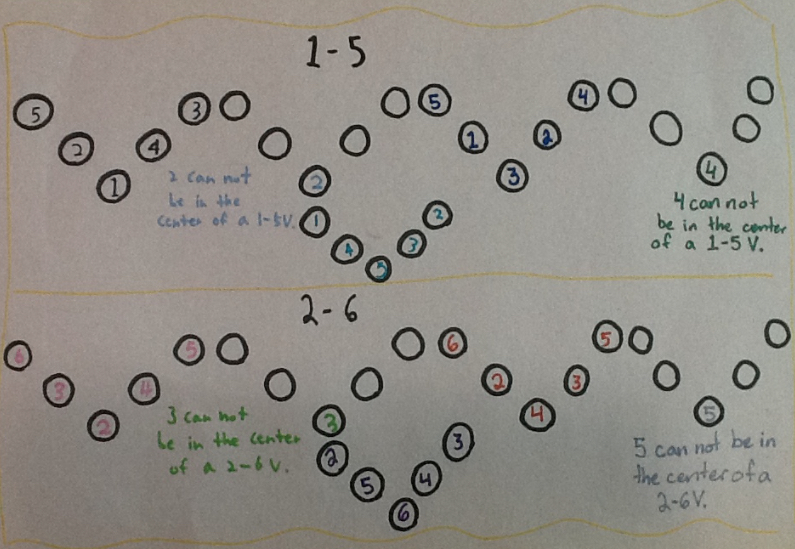Or search by topic
Number and algebra
Geometry and measure
Probability and statistics
Working mathematically
Advanced mathematics
For younger learners
Magic Vs



- Problem
- Getting Started
- Student Solutions
- Teachers' Resources
Well done to everybody who had a go at this problem.
Somin, Kim and Georgia from the American International School Chennai in India sent in the following explanation:
To do this problem, we started with the lowest circle on the V, because this would affect both arms. Then, we took the highest of the remaining numbers, and the lowest of the remaining numbers and added them together. We then compared the sum of those to the sum of the two middle/in-between remaining numbers. If the sums were the same, we entered the addends used to make
those two sums into the 2 spots on each arm of the V.
We know that we found every solution because when trying to mix up the pairs of numbers to make other sums, none of the sums were equal. The only way you could make another V is if you mirrored one we already made, or switched the places of the top and middle circles of each arm. A pattern we noticed during this project is that every even number in the sequence (the 2nd
and 4th numbers, not 2 and 4, for example) did not work as a center number. The other numbers could not be paired to create equal sums. We are including a small picture we made representing our work.

Ethan from Hong Kong International School agreed that 2 and 4 cannot be in the centre of the V:
I think that there are 24 solutions because only odd numbers can be on the bottom circle, and there are three odd numbers. Additionally, the two numbers on both sides can be switched. Also, the two on the right can be switched. Finally, the two on the left can be switched, which makes an equation: 3x2x2x2.
Hwan from Hong Kong International School had some similar ideas:
There are 24 solutions. I tried using equations to solve it. I first found one solution, then found that the left middle and the left top can switch while leaving the right side alone, then switching the right side and leaving the left alone, then switching both sides. Then I switched the entire left side to the entire right side and did the process again. Since I found that there are 4 solutions before switching the entire left to the right, I do 4 times 2 which is 8. Now I have to multiply that by 3 because only the odd numbers can be at the bottom, and there are 3 odd numbers through 1-5. The equation is 2 times 4 times 3 which equals 24.
Here is Maisy and Jessica's submission:
We first found our first three Vs then realised we could find 8 solutions, by just changing one V. This also happened with the other two Vs. We multiplied 8 by 3 because our three vs had 8 solutions. Our answer was 24 solutions.
E.g. To start with, we had 23541 and we swapped the sides to get 41532.
Then we changed round the sides to get 14523. Afterwards, we just swapped one side then another till we couldn't swap it anymore without getting a solution we already had.
Here is Mollie and Amelia's results:
To solve all of the solutions,first we decided to put 1 as the bottom number and worked systematically to get all 8 solutions. Then, we picked then number 3 for the bottom number as we knew it couldn't be even. After finding 8 answers, we got 5 for the number at the bottom. We found all the answers for that number. We stopped here since we couldn't go above 5.There are 24 solutions.
Matty from The British School Manila in the Philippines sent in the following exhaustive solution:
If we have the numbers 1, 2, 3, 4 and 5, and our goal is to arrange all 5 numbers in a way such that the 2 'arms' have the same total. If we get the total of all the give numbers, we get 15. In the middle, we must have an odd number, because if we have an even, say 2, 15-2=13 and 13 is not divisible among the other 2 circles of arms. If we pick 1 as the middle, then each side is required to have a total of 7 on the other 2 circles. For 3, we need a total of 6 on the 2 circles, and for 5, we need a total of 5 on the other 2 circles. Thanks for the question, Nrich.
5,2,1,3,4 5,2,1,4,3 2,5,1,3,4 2,5,1,4,3 3,4,1,5,2 3,4,1,2,5
4,3,1,5,2 4,3,1,2,5 1,5,3,2,4 1,5,3,4,2 5,1,3,2,4 5,1,3,4,2
2,4,3,1,5 2,4,3,5,1 4,2,3,1,5 4,2,3,5,1 1,4,5,2,3 1,4,5,3,2
4,1,5,2,3 4,1,5,3,2 2,3,5,1,4 2,3,5,4,1 3,2,5,1,4 3,2,5,4,1
We have 24 different permutations. Here is the formula:
Slot 1: 4 possibilities
Slot 2: 1 possibility
Slot 3: 2 possibilities
Slot 4: 1 possibility
Middle number: 3 possibilities (3 odd numbers between 1 to 5, inclusive)
So 3*(4*1*2*1) = 24.
We also had some very interesting solutions from North London Collegiate School that are certainly worth viewing here.
magic Vs Y4.pdf magic Vs 3S group.pdf magic Vs Ronis group.pdf
Thank you all so much for these solutions.
Related Collections
You may also like
Consecutive Numbers
An investigation involving adding and subtracting sets of consecutive numbers. Lots to find out, lots to explore.
Roll These Dice
Roll two red dice and a green dice. Add the two numbers on the red dice and take away the number on the green. What are all the different possible answers?

